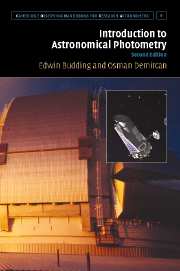Book contents
- Frontmatter
- Contents
- Preface to first edition
- Preface to second edition
- 1 Overview
- 2 Introduction
- 3 Underlying essentials
- 4 Themes of astronomical photometry
- 5 Practicalities
- 6 Procedures
- 7 Basic light curve analysis
- 8 Period changes in variable stars
- 9 Close binary systems
- 10 Spotted stars
- 11 Pulsating stars
- Appendix
- Author index
- Subject index
10 - Spotted stars
Published online by Cambridge University Press: 13 August 2009
- Frontmatter
- Contents
- Preface to first edition
- Preface to second edition
- 1 Overview
- 2 Introduction
- 3 Underlying essentials
- 4 Themes of astronomical photometry
- 5 Practicalities
- 6 Procedures
- 7 Basic light curve analysis
- 8 Period changes in variable stars
- 9 Close binary systems
- 10 Spotted stars
- 11 Pulsating stars
- Appendix
- Author index
- Subject index
Summary
Introductory background
‘Starspots’ are not a new notion. There was a time when starspots were offered as a general explanation of stellar variability. From that extreme, in the nineteenth century, attention to the hypothesis had dwindled away almost completely after the development of stellar spectroscopy, until, in a well-known pair of papers dealing with the cool binaries AR Lac and YY Gem in the 1950s, the photometrist Gerald Kron revived it. As events have turned out, there is now a good deal of evidence to support Kron's conjecture, for certain groups of cool variable.
The two stars that Kron referred to are good examples of somewhat different but related categories of ‘active cool star’ (see Figures 10.1 and 10.2) – stars of spectral type generally later than mid-F, i.e. associated with convective outer regions, and usually having a relatively rapid rotational speed. In the cases of AR Lac and YY Gem, both close binary systems, this rapid rotation is a consequence of tidally induced synchronism between rotation and orbital revolution. The M type dwarf components of YY Gem are typical flare stars, characterized by Balmer line emissions that on occasions become very strong, reminiscent of solar flares, but with much greater relative intensity. AR Lac also shows ‘chromospheric’ emission lines, but its particular configuration, G5 and subgiant K0 stars in a ∽2 day period binary, places it as a standard RS CVn type binary.
- Type
- Chapter
- Information
- Introduction to Astronomical Photometry , pp. 341 - 374Publisher: Cambridge University PressPrint publication year: 2007



